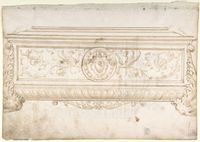
Songs of Innocence and of Experience, Shewing the Two Contrary States of the Human Soul: Combined Title-page
William Blake
An item at Metropolitan Museum of Art
Blake etched twenty-seven printing plates for Songs of Innocence in 1789, completing those for the Songs of Experience in 1794. He then printed and hand-colored copies of the combined sets over succeeding decades as patrons ordered them, each one visually distinct. Verse and image work together to celebrate poetic inspiration and reveal aspects of the divine as expressed through nature. The poetic voice is often that of a child, whose emotions range from delight to fear, with darker feelings usually resolved in the earlier Songs of Innocence by adult intervention. This first group of Songs was shaped by the heady early days of the French Revolution, when British liberals and radicals believed that true reform was imminent on both sides of the Channel. By contrast, the tone of the later Songs is dark, even despairing. Children experience inexplicable cruelty at the hands of adults and the poet offers neither rescue nor resolution. These works were shaped by the later stages of the French Revolution, which was marked by regicide, the Terror, and repression of radical thinkers in Britain. The artist Edward Calvert met Blake around 1825 and commissioned this copy of Songs of Innocence and of Experience soon thereafter. These richly decorated pages, with their deeply saturated hues and distinctive ornamental borders, reveal Blake’s late vision and the order is established by small red numbers at upper right. This copy of Songs was later the first work to be purchased by the Museum’s new Department of Prints in 1917, recommended by its distinguished curator William M. Ivins, Jr.
Drawings and Prints
An exhibit at Metropolitan Museum of Art
The Department’s vast collection of works on paper comprises approximately 21,000 drawings, 1.2 million prints, and 12,000 illustrated books created in Europe and the Americas from about 1400 to the present day. Since its foundation in 1916, the Department has been committed to collecting a wide range of works on paper, which includes both pieces that are incredibly rare and lauded for their aesthetic appeal, as well as material that is more popular, functional, and ephemeral. The broad scope of the department’s collecting encourages questions of connoisseurship as well as those pertaining to function and context, and demonstrates the vital role that prints, drawings, and illustrated books have played throughout history.




